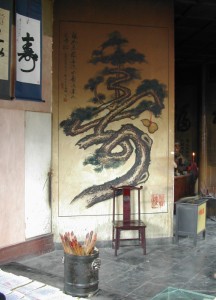Traditional and Simplified Characters
國/国….車/车….電/电….醫/医….壽/寿….無/无
Side-by-side examples of Traditional and Simplified Characters
| Traditional Character | Simplified Character | Pinyin | CNPA | Definition |
| 國 | 国 | guó | ㄍㄨㄛˊ | country; nation -n. |
| 車 | 车 | chē | ㄔㄜ | automobile; car; vehicle -n. |
| 電 | 电 | diàn (pron.: dien4) | ㄉ一ㄢˋ | electricity; electrical -n./adj. |
| 醫 | 医 | yī (pron.: ee1) | 一 | doctor; medicine -n. cure; treat -v. |
| 壽 | 寿 | shòu (pron.: show4) | ㄕㄡ` | longevity; long life; age -n. |
| 無 | 无 | wú (pron.: oo2) | ㄨ´ | no; not; not have; without; nothing; nil -v./n./adj./adv. |
Above- some examples of traditional characters and their simplified equivalents
Chinese characters have been developing in China for more than 3,000 years. In the ancient period, as the characters were developing, it was envisioned that there should be pronunciation cues in the characters by making a part of the character the ‘meaning component’ and part of the character the ‘sound component’.
But, as the characters continued to develop and became more and more complex, this ‘rule’ was violated so often, that, even given the presence of a sound component in a character, Chinese people recognize that this sound component will be a correct clue to the pronunciation only about 80% of the time. (Note that the sound components are not phonetic in nature, and have to do with the pronunciation families of some radicals.)
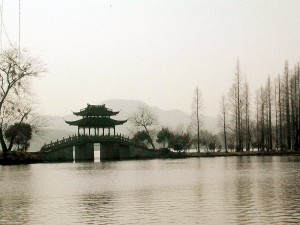 A covered bridge on West Lake in Hángzhōu, Zhèjiāng.
A covered bridge on West Lake in Hángzhōu, Zhèjiāng.
In the 19th century some examples of early Chinese writings were found inscribed on tortoise shells. At the beginning of the 20th century, these inscriptions were recognized to be more than 3000-year-old writings from the Shāng Dynasty period (approx. 1600-1000 bce). These ‘tortoise-shell writings’ are samples of some of the earliest Chinese characters discovered.
In fact, historically there have been more than 70,000 and perhaps as many as 80,000 characters created and used, although only a small portion of them are used in China today.
It is commonly asserted that in order to read a newspaper in China, the reader must know about 3,000 characters. It is also said that these 3,000 characters cover about 99% of the characters appearing in modern books and newspapers, and of these, about 950 of them occur in 90% of reading situations.
So, the language doesn’t require quite as much memorization as might seem necessary from the absolute number of characters in use: with these 950 characters, the student can functionally read just about any common book or magazine, with only an occasional need to resort to a dictionary.
Chinese students may learn up to 5,000 characters through high school (although an accurate count is impossible,) and those who continue to study in university may learn several hundred to a thousand or more additional characters.
University professors and literary scholars may be able to recognize in the range of 6-10,000 characters: clearly a prodigious feat.
Chinese students study their own language, (both its characters and its literature), intensively, and for a long time …certainly longer than Westerners study their native languages. This makes sense if you understand that historical Chinese writings go back for thousands of years, while in the West, our recorded history and our languages are sometimes substantially shorter.
In addition, (at least for English speakers,) the literary works of our predecessor civilizations are in other languages: Ancient Greek, Latin, German, French, Danish, (not to mention Ancient Egyptian, Phoenician, Persian, Hebrew and other languages,) and are thus unintelligible to us. The Chinese are able to at least read, if not necessarily immediately understand without study, Ancient and Classical Chinese texts.
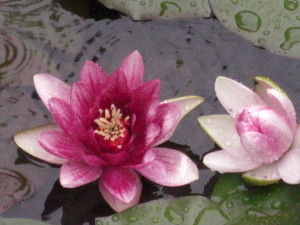 Lotus flowers in a pool in the rain.
Lotus flowers in a pool in the rain.
This extended study is a very expensive task for Chinese schools. Since China has been poor for most of the period of the Qīng Dynasty (1644-1912 ce), and even beyond that through the 20th century, education for Chinese students has been both expensive and often historically very hard to come by.
After the 1949 Communist victory in the Chinese civil war, the central government promulgated a system of simplified characters that allowed the easier writing of characters, (and also somewhat less expense in teaching the characters, as they could be learned faster.)
It should be noted that it is estimated that there are presently some 300 million school-aged children in China (probably more than the entire population of the US.) Assuming that the Chinese population in the early 1950s was half of its present-day size, the population of China could have been in the range of 4-600 million people (or more).
That would mean that the school-age population was probably at least 100 million students: likely much more. That’s a large number for any country to educate, and China was very poor then, having just come out of at least 30 bloody years of revolution and civil war, and over 10 years of war with Japan as well.
So anything that made the language easier to learn and cheaper to teach was very welcome to the Chinese government. Note also that in the early 1950s China was undergoing a crash program to produce 100% literacy (which was substantially successful a dozen years later, by the end of the 1960s).
How Characters Were Simplified
Characters were simplified in three ways:
1. The first simplification method was accomplished by going through the 214 radicals of the Chinese language (called the ‘Kāngxī’ [pron.: kang shee] Radicals,) and making them writable with fewer strokes. By simplifying the radicals, thousands of characters were indirectly acted on, making characters easier to write and also easier to remember.
- A stroke is any single line written without lifting the pen or brush, in the writing of a printed (as opposed to cursively written) character.
- Radicals are fundamental standardized components of Chinese characters made up of various kinds of strokes. Most printed Chinese-English dictionaries will give a listing of the 214 Kāngxī Radicals either in a preface, or in a Radical Index at the back.
Note that the Celadon Dragon Chinese Dictionary contains 4 different listings of all 214 Kāngxī Radicals, each listing organized differently and all easily accessible, as well as reports displaying all characters assigned to each radical. These “KXR” reports allow the student a better conceptual understanding of the classification system of Chinese characters, as well as a better practical understanding of the use of the KXR system.
- Examples of traditional characters that are also used as radicals and their simplified equivalents:
| Traditional Character | Simplified Character | Pinyin | CNPA Symbol | Definition |
| 食 | 饣 | shí | ㄕ´ | food -n. |
| 馬 | 马 | mǎ | ㄇㄚˇ | horse -n. |
| 門 | 门 | mén | ㄇㄣ´ | door -n. |
| 見 | 见 | jiàn (pron.: jien4) | ㄐ一ㄢ` | see; meet with -v. view; opinion -n. |
| 言 | 讠 | yán (pron.: yen2) | 一ㄢ´ | speak; talk -v. word; character -n. |
2. For other traditional characters, a small portion or section of the character became the simplified character.
- Examples of traditional characters for which the simplified equivalents are only a part of the traditional character:
| Traditional Character | Simplified Character | Pinyin | CNPA Symbol | Definition |
| 檸 | 柠 | níng | ㄋ一ㄥ´ | lemon -n. |
| 鬚 | 须 | xū (pron.: shu1) | ㄒㄩ | beard; mustache -n. |
| 幹 | 干 | gàn | ㄍㄢ` | do; work -v. |
| 誇 | 夸 | kuā | ㄎㄨㄚ | exaggerate; boast -praise -v. |
| 氣 | 气 | qì (pron.: chee4) | ㄑ一` | air; gas -manners -breath -spirit |
3. For a very small number of traditional characters, completely new simplified characters were created.
- Examples of traditional characters for which completely new simplified characters were created:
| Traditional Character | Simplified Character | Pinyin | CNPA Symbol | Definition |
| 衛 | 卫 | wèi | ㄨㄟˋ | defend; guard; protect -v. |
| 壞 | 坏 | huài | ㄏㄨㄞ` | go bad; spoil; ruin -v. bad -adj. |
| 華 | 华 | huá | ㄏㄨㄚ´ | splendid; brilliant -adj. -China -n. |
| 專 | 专 | zhuān (pron.: juan1) | ㄓㄨㄢ | specialize -concentrate -v. |
| 個 | 个 | gè | ㄍㄜˋ | general quantifier; measure word |
China and Simplified Characters
Simplified characters are taught in Chinese schools and universities and used in books and newspapers in China.
It is not unusual, however, to occasionally see traditional characters there, sometimes as a reflection of the past (for instance, some, carved on rocks in historic places, can be hundreds or even thousands of years old, while others may be found on door lintels of old temples and public buildings).
Interestingly, new buildings in contemporary China increasingly use traditional rather than simplified characters on their door lintels and in their public areas both for the building’s names as well as for decoration, as the government eases its insistence on the use of simplified characters. Chinese people generally prefer the beauty of traditional characters to the simplified characters. When writing, however, all Chinese use simplified characters.
 Iconic karst formations in Guìlín, Guǎngxī.
Iconic karst formations in Guìlín, Guǎngxī.
In China, the study of traditional characters is usually left to art students specializing in the study of calligraphy or those studying the Chinese classics. However, since traditional characters are still relatively ubiquitous in China, many (if not most) educated Chinese will be familiar with the traditional as well as the simplified versions of many characters.
Táiwān, Hong Kong and Traditional Characters
Contrariwise, in Táiwān, Hong Kong and Macao traditional characters are still in common use, and students study them rather than simplified characters. Many of the Mainland Chinese simplified characters are not used at all in Táiwān, and are just beginning to penetrate into Hong Kong since the ’97 Handover, although they are not yet used in popular books or newspapers.
When hand writing characters, however, Hong Kong people and Táiwānese may write either the traditional character, or, if there are simplified versions of the character, they may habitually use one of the simplified versions …which may or may not be the same as the equivalent simplified character used in China.
In Táiwān, usually only business people who regularly visit China will easily recognize some of the Mainland simplified characters, although this is not a hard and fast rule. Since most of the simplifications are derived from traditional characters they will often be understood by Taiwanese, who clearly see the relation between the simplified characters and their traditional antecedents.
Some of the Mainland simplifications however, bear no relation to the corresponding traditional characters, and for those, Táiwānese generally remain completely unaware.
Characters as Art: Chinese Calligraphy
Chinese consider their characters to be as much an art form as a means of written communication …and a school of calligraphic art is devoted to the study and practice of writing beautiful Chinese characters. Traditionally, an artist included calligraphy among his works, either as individual works, or with characters included in pictures.
Calligraphy is taught in art schools and the art departments of universities, and involves writing characters with an old-style Chinese writing brush in any of a number of different formal and informal styles. All Chinese study calligraphy by the time they graduate high school: some spend their lives trying to perfect their ability to write beautiful characters.
As calligraphy can be anything from a single well-executed character to ancient poems or well-known Chinese texts, a Chinese person who is able to write beautiful characters is considered to be both highly literate and erudite to the Chinese.
Note that while many Chinese are able to quote old texts, the texts being a basic part of Chinese education and fundamental to the culture, not everyone is able to write them letter-perfect, and in a ‘beautiful hand’ as well. That is something unusual …and is respected for its difficulty as well as its evidence of erudition. (Remember, too, that this is a Confucian society, and that Confucius was a teacher: teachers and learning are at the pinnacle of this society, or, looked at another way, are the foundation of this society.)
In China, foreign language-students are also encouraged to study calligraphy. Many find it both fun and pleasurable: some even do it well.
Occasionally, however, you will see peasants doing calligraphy using simplified characters. This may be a statement as much about education as about anything else: peasants in the countryside are unlikely to have extensive exposure to traditional characters. Even so, the Chinese people genuinely love their characters and their beauty. And, since writing calligraphy is art, all writers of calligraphy are artists!
In Běijīng parks in the summertime, you can see men and women practicing writing characters on the hot pavement using brushes the size of mops with pails of water for use as ink. There will usually be a crowd of people standing around the calligraphers, commenting on the characters in a good-natured way, occasionally congratulating one or another writer for a particularly beautiful character before the character evaporates.
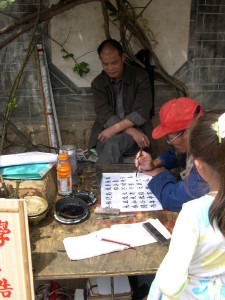 Old man doing calligraphy in a village.
Old man doing calligraphy in a village.
One often sees old people practicing calligraphy: at the side of a road in a peasant village one can find an old man with a small stool, a folding table, paper, inkslab and brushes, writing characters and quotes for a crowd of locals, sometimes accepting a few ‘jiǎo’ [角] (dimes) in return. (See photo below, right.)
Calligraphy is usually done using traditional characters, because simplified characters just don’t have the beauty of the traditional characters.
Many (if not most) Chinese homes have calligraphy scrolls on the wall.
Language Study in China and Taiwan
Be aware also that study in China for foreigners is a relatively inexpensive endeavor, and that there are both direct and indirect Chinese government subsidies involved in study by foreign students, particularly for young people (it’s the young who change the future …Chinese thinking, or just forward thinking?)
Serious students of the language should certainly include plans to spend at least some time studying in any one of the many Chinese universities that include foreign students among their student populations.
Many (if not most,) of these universities have specific educational and living facilities set aside exclusively for the education of foreign language-students.
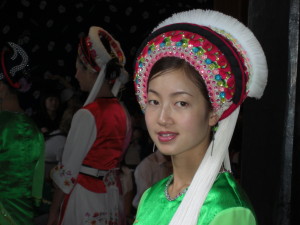 A young Dai woman in Dai unmarried woman’s headdress in Lìjiāng, Yúnnán.
A young Dai woman in Dai unmarried woman’s headdress in Lìjiāng, Yúnnán.
Táiwān, on the other hand, because of its higher standard of living, is somewhat more expensive, (but still less expensive than the U.S.), as well as a good experience for the serious student.
The atmosphere in Táiwān is less restrictive than in China: it is easier for Westerners living in Táiwān’s more Westernized society, and the student will usually study traditional characters there, instead of the Mainland’s simplified characters.
A well-rounded education in Chinese language and culture certainly should include some knowledge of and exposure to traditional characters, in this writer’s opinion.
The foreigner studying in either China or Táiwān will find the Chinese people to be very friendly, and (both a point of pride to all Chinese and an important part of Chinese culture), exceedingly polite.
Multilingual Chinese
As mentioned earlier, China is a linguistically complex place. Most people are at least bilingual, and some Chinese or Táiwānese may speak three or even four Chinese languages, as well as English.
In many places in China, people are likely to mix their local language and Chinese together, both in the same conversation as well as in the same sentence. In Táiwān in particular, in the same conversation, one is also highly likely to hear some English or possibly even Japanese words used.
Since people usually prefer to speak their native language, and also since many people are equally able in both their mother tongue as well as in Chinese, it is very possible to hear conversations where one person speaks the place-language or the provincial language, (that person’s mother-tongue,) and another answers in Chinese (that person’s mother-tongue or preferred language).
So, when studying in China or Táiwān and listening to others speak, do not immediately assume, if you don’t understand what’s being said, that your Pǔtōnghuà comprehension is at fault …you must first listen and determine if the person is speaking Chinese, or a provincial or place-language, or two languages mixed together, or is speaking with such a heavy accent as to disguise the fact that they are actually speaking Pǔtōnghuà! (Actually, it’s a good idea to ask them …and also a good way to strike up a conversation with Chinese people: they love to talk about their languages with foreigners.)
Home Back Top of Page Next Page
© R. Teller, 2015
